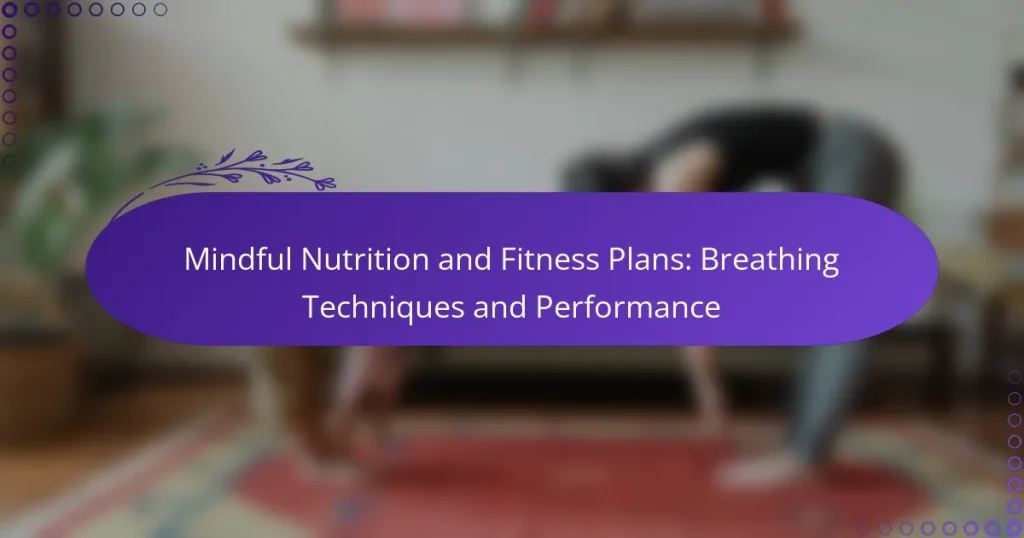Mindful nutrition and fitness plans are essential for enhancing athletic performance and overall well-being. By focusing on intentional food choices and effective breathing techniques, athletes can optimize their energy levels, improve focus, and support recovery. This holistic approach fosters a deeper awareness of how nutrition and breath impact physical capabilities, leading to better outcomes in training and competition.

How can mindful nutrition improve fitness performance?
Mindful nutrition enhances fitness performance by promoting better food choices, optimizing energy levels, and supporting recovery. By being aware of what and how you eat, you can fuel your body more effectively, leading to improved overall athletic outcomes.
Enhanced energy levels
Mindful nutrition helps maintain stable energy levels throughout the day, which is crucial for optimal performance. Consuming a balanced diet rich in whole foods, such as fruits, vegetables, lean proteins, and healthy fats, can provide sustained energy rather than quick spikes followed by crashes.
Consider timing your meals and snacks around workouts. Eating a mix of carbohydrates and proteins 1-2 hours before exercising can enhance endurance and strength. Avoiding heavy or processed foods before workouts can prevent sluggishness.
Improved recovery times
Proper nutrition plays a vital role in recovery after physical activity. Mindful eating encourages the intake of nutrients that aid muscle repair and reduce inflammation, such as omega-3 fatty acids, antioxidants, and adequate hydration.
Incorporate protein-rich foods post-exercise, like Greek yogurt or a protein shake, within 30 minutes to help speed up recovery. Aim for a balanced meal within a couple of hours that includes carbohydrates to replenish glycogen stores and proteins for muscle repair.
Better mental focus
Mindful nutrition can significantly enhance mental clarity and focus, which are essential for peak performance. Foods rich in omega-3 fatty acids, antioxidants, and vitamins can support brain health and cognitive function.
Incorporate foods like fatty fish, nuts, and leafy greens into your diet. Staying hydrated is equally important; even mild dehydration can impair concentration. Aim for at least 2-3 liters of water daily, adjusting based on activity levels and climate.

What are effective breathing techniques for athletes?
Effective breathing techniques for athletes enhance performance, improve focus, and aid recovery. These methods help regulate oxygen intake and promote relaxation, which can be crucial during training and competition.
Diaphragmatic breathing
Diaphragmatic breathing, also known as abdominal or belly breathing, involves engaging the diaphragm fully. This technique allows for deeper breaths, increasing oxygen exchange and promoting relaxation.
To practice, inhale deeply through the nose, allowing the abdomen to expand, and then exhale slowly through the mouth. Aim for a rhythm of 4-5 seconds in and 4-5 seconds out. This method can be particularly beneficial before high-stress events.
Box breathing method
Box breathing is a structured technique that involves four equal phases: inhale, hold, exhale, and hold again, each lasting about 4-5 seconds. This method helps to calm the mind and body, making it ideal for athletes before competitions.
To implement box breathing, inhale for 4 seconds, hold for 4 seconds, exhale for 4 seconds, and hold again for 4 seconds. Repeat this cycle for several minutes to enhance focus and reduce anxiety.
4-7-8 breathing technique
The 4-7-8 breathing technique promotes relaxation and can improve sleep quality, making it useful for athletes recovering from intense workouts. This method involves inhaling for 4 seconds, holding the breath for 7 seconds, and exhaling for 8 seconds.
To practice, find a comfortable position, inhale deeply through the nose for 4 seconds, hold the breath for 7 seconds, and exhale completely through the mouth for 8 seconds. Repeat this cycle 4-5 times to help lower heart rate and stress levels.

How to create a mindful nutrition plan?
Creating a mindful nutrition plan involves being intentional about food choices, focusing on whole, nutritious ingredients, and understanding your body’s needs. This approach encourages awareness of what you eat and how it affects your overall health and performance.
Incorporate whole foods
Whole foods are minimally processed and free from artificial ingredients, making them a cornerstone of a mindful nutrition plan. Incorporating fruits, vegetables, whole grains, lean proteins, and healthy fats can enhance nutrient intake and support better health outcomes.
Focus on seasonal and local produce to maximize freshness and flavor. For example, aim to fill half your plate with vegetables and fruits at each meal, which can help you stay satisfied while providing essential vitamins and minerals.
Balance macronutrients
A balanced intake of macronutrients—carbohydrates, proteins, and fats—is crucial for optimal performance and energy levels. A general guideline is to aim for a distribution of about 45-65% carbohydrates, 10-35% protein, and 20-35% fats, adjusting based on individual needs and activity levels.
Consider including a source of protein with each meal, such as chicken, beans, or tofu, and complementing it with healthy fats like avocados or nuts. This balance helps maintain energy and supports muscle recovery after workouts.
Plan meals ahead
Meal planning is an effective strategy for ensuring you stick to your mindful nutrition goals. By preparing meals in advance, you can avoid last-minute unhealthy choices and ensure you have nutritious options readily available.
Start by dedicating a few hours each week to plan and prep meals. Create a shopping list based on your planned meals to avoid impulse buys. Consider batch cooking grains or proteins and storing them in the fridge or freezer for easy access throughout the week.

What fitness plans complement mindful nutrition?
Fitness plans that align with mindful nutrition focus on holistic well-being, integrating physical activity with healthy eating habits. These plans often emphasize balance, flexibility, and strength, enhancing overall performance and mental clarity.
Yoga for flexibility
Yoga is an excellent fitness plan that promotes flexibility, balance, and mindfulness. It encourages deep breathing and body awareness, which can enhance your connection to nutrition and overall health. Regular practice can improve muscle elasticity and joint mobility, making it easier to engage in other physical activities.
To incorporate yoga into your routine, aim for sessions lasting between 30 to 90 minutes, two to three times a week. Focus on poses that stretch major muscle groups, such as Downward Dog, Warrior II, and Pigeon Pose. Consider joining a local class or following online tutorials for guidance.
High-intensity interval training
High-intensity interval training (HIIT) is a time-efficient workout that alternates between short bursts of intense exercise and recovery periods. This approach can boost cardiovascular fitness and metabolic rate, making it a powerful complement to mindful nutrition. HIIT workouts can typically be completed in 20 to 30 minutes, making them accessible for busy schedules.
When planning a HIIT session, include exercises like sprinting, jumping jacks, or burpees, followed by rest or low-intensity activities. Aim for a work-to-rest ratio of 1:2 or 1:1, depending on your fitness level. Be mindful of your body’s signals to avoid overtraining.
Strength training routines
Strength training routines focus on building muscle and improving overall strength, which can enhance physical performance and support metabolic health. Incorporating resistance exercises into your fitness plan helps maintain muscle mass, especially as you age, and complements mindful nutrition by promoting a balanced body composition.
Consider a routine that includes compound movements such as squats, deadlifts, and bench presses, performed two to three times a week. Aim for 8 to 12 repetitions per set, adjusting weights to ensure you can complete the sets with proper form. Always prioritize safety by using correct techniques and allowing adequate recovery time between sessions.

What are the benefits of combining nutrition and fitness?
Combining nutrition and fitness enhances overall well-being by optimizing physical performance and supporting mental health. This synergy can lead to improved energy levels, better recovery times, and a more balanced lifestyle.
Holistic health improvement
Integrating nutrition with fitness promotes holistic health by addressing both physical and mental aspects of well-being. A balanced diet fuels workouts, while regular exercise can improve mood and cognitive function. Together, they help reduce the risk of chronic diseases such as obesity, diabetes, and heart disease.
For example, consuming nutrient-dense foods like fruits, vegetables, and whole grains provides the necessary vitamins and minerals to support muscle recovery and immune function. This combination can lead to a more resilient body and mind.
Increased motivation
When nutrition and fitness are combined, individuals often experience heightened motivation to maintain their health goals. A nutritious diet can enhance energy levels, making workouts feel less daunting and more enjoyable. This positive feedback loop encourages consistency in both eating and exercising.
Setting small, achievable goals related to both nutrition and fitness can further boost motivation. For instance, aiming to prepare healthy meals for the week or gradually increasing workout intensity can create a sense of accomplishment and drive.
Long-term lifestyle changes
Combining nutrition and fitness fosters sustainable lifestyle changes that can last a lifetime. By establishing healthy eating habits alongside a regular exercise routine, individuals are more likely to maintain these practices over time. This approach can lead to lasting improvements in health and quality of life.
To support long-term changes, consider creating a balanced meal plan that aligns with your fitness routine. Tracking progress and celebrating milestones can also reinforce commitment to a healthier lifestyle. Avoiding extreme diets or workout regimens is crucial, as these can lead to burnout and discourage long-term adherence.

How to assess the effectiveness of nutrition and fitness plans?
Assessing the effectiveness of nutrition and fitness plans involves tracking various performance indicators, energy levels, and mental well-being. These factors provide a comprehensive view of how well a plan supports your health and fitness goals.
Track performance metrics
Performance metrics are quantifiable measures that help gauge the success of your nutrition and fitness plans. Common metrics include weight, body composition, strength levels, and endurance. Regularly recording these figures can help identify trends and areas for improvement.
For example, if you notice a consistent increase in your lifting weights or a decrease in your mile time, it indicates that your fitness plan is effective. Aim to track these metrics weekly or bi-weekly to maintain a clear picture of your progress.
Monitor energy levels
Energy levels are crucial indicators of how well your nutrition and fitness plans are working. High energy levels typically suggest that your diet is providing adequate nutrients and that your fitness routine is well-balanced. Conversely, persistent fatigue may signal that adjustments are needed.
Consider using a simple scale from 1 to 10 to rate your daily energy levels. If you consistently rate below a 5, it may be time to reassess your caloric intake or the intensity of your workouts.
Evaluate mood and mental clarity
Mood and mental clarity are often overlooked but are essential for assessing the effectiveness of your nutrition and fitness plans. A well-rounded diet and regular exercise can enhance mood and cognitive function, while poor nutrition or lack of activity can lead to irritability and fogginess.
Keep a journal to note your mood and mental clarity alongside your physical metrics. If you find that your mood improves with certain dietary changes or workout routines, it may be worth incorporating those elements more consistently into your plan.


